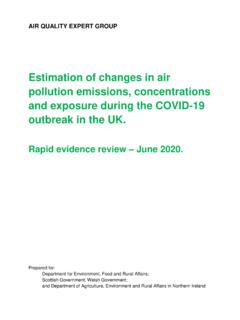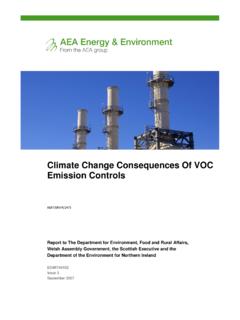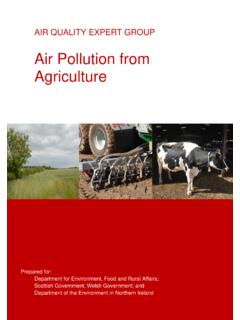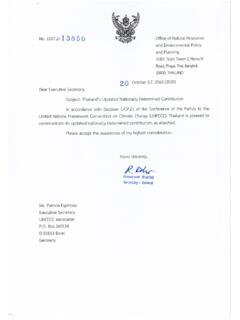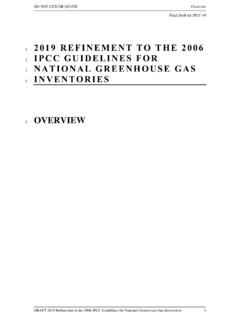Transcription of Carbon factors of biofuels - GOV.UK
1 Carbon factors of biofuels | i NAEI in Confidence ED11471 | Final Report | Date 18/05/2018 NAEI in Confidence Carbon factors of biofuels Final Report _____ Prepared by Ricardo Energy & Environment for the Department for Business, Energy and Industrial Strategy Carbon factors of biofuels | ii NAEI in Confidence Customer: Contact: Department for Business, Energy and Industrial Strategy Peter Brown t: +44 1235 753 273 e: Authors: Confidentiality, copyright & reproduction: Peter Brown, Eduardo Hancock, Glen Thistlethwaite, John Watterson This report is the Copyright of the Department for Business, Energy and Industrial Strategy. It has been prepared by Ricardo Energy & Environment, a trading name of Ricardo-AEA Ltd, under contract to the Department for Business, Energy and Industrial Strategy dated 26/02/2018. The contents of this report may not be reproduced in whole or in part, nor passed to any organisation or person without the specific prior written permission of the Department for Business, Energy and Industrial Strategy.
2 Ricardo Energy & Environment accepts no liability whatsoever to any third party for any loss or damage arising from any interpretation or use of the information contained in this report, or reliance on any views expressed therein. Approved By: Glen Thistlethwaite Date: 18/05/2018 Signed: Carbon factors of biofuels | iii NAEI in Confidence Table of contents 1 Introduction .. 1 Summary of Current 1 Literature Review and References .. 4 Stakeholder Consultation .. 4 Summary of study recommendations .. 4 2 Project findings by mixed fuel .. 5 Municipal Solid Waste and Solid Recovered Fuel .. 5 Current understanding and known challenges .. 5 Findings in this project .. 5 Suggestions for future 6 Smokeless Solid Fuel .. 6 Current understanding and known challenges .. 6 Findings in this project .. 6 Suggestions for future 6 Scrap Tyres .. 7 Current understanding and known challenges.
3 7 Findings in this project .. 7 Suggestions for future 8 3 Project findings by biogenic fuel .. 8 Biodiesels .. 8 Current understanding and known challenges .. 8 Findings in this project .. 8 Suggestions for future 8 Bioethanol .. 8 Current understanding and known challenges .. 8 Findings in this project .. 9 Suggestions for future 9 Bio-MTBE and biomethanol .. 9 Current understanding and known challenges .. 9 Findings in this project .. 9 Suggestions for future 9 Biogases (landfill gas, sewage gas, other biogases) .. 9 Current understanding and known challenges .. 9 Findings in this project .. 10 Suggestions for future 10 Charcoal .. 11 Current understanding and known challenges .. 11 Findings in this project .. 11 Suggestions for future 11 Liquid biofuels (for stationary combustion) .. 11 Current understanding and known challenges .. 11 Findings in this project.
4 11 Suggestions for future 12 Other biomass used in power stations (poultry litter, straw) .. 12 Current understanding and known challenges .. 12 Findings in this project .. 12 Suggestions for future 12 Wood/solid biomass .. 12 Current understanding and known challenges .. 12 Findings in this project .. 12 Suggestions for future 14 Carbon factors of biofuels | 1 NAEI in Confidence 1 Introduction Carbon dioxide emissions originating from the combustion of biofuels are reported to the United Nations Framework Convention on climate change (UNFCCC) as part of the UK s greenhouse Gas Inventory (GHGI) submission, but do not contribute to the national total. Currently, emissions are calculated using fuel combustion statistics, predominantly from the Digest of UK Energy Statistics (DUKES), and a suitable emission factor. The Carbon emission factors currently in use are largely taken from the 2006 intergovernmental Panel on climate change (IPCC) guidelines , the Joint Research Centre (JRC) and Concawe s Well to Wheels report (2014), or derived from industrial regulator inventories ( the Environment Agency s Pollution Inventory).
5 Estimated emissions of CO2 from biofuels have increased from around 3 Mt CO2 in 1990, to around 38 Mt in 2016. The relative contribution of sources has also changed significantly, with wood combustion in power stations now accounting for approximately 34% of bio- Carbon emissions, and biofuels in road transport accounting for approximately 8%. There were no emissions from these sources in 1990. Determining more accurate data on bio- Carbon emissions is important for the national and sub- national inventories, company reporting factors outputs for corporate reporting and to improve the underpinning evidence-base for Government policy development such as the imminent Bioenergy Strategy and the climate change Committee s review of advice to Government on bioenergy. Summary of Current Understanding Carbon dioxide of biogenic origin is not mandatory to report in national greenhouse gas inventories, hence, estimating these emissions have been a low priority and the UK national Atmospheric Emission Inventory (NAEI) estimates of biogenic Carbon are less complete and robust than the rest of the inventory.
6 Table 1 presents the current emission factors for Carbon of biogenic origin used in the NAEI. The biofuels are grouped alphabetically in the first column, by source. The contribution to total biogenic greenhouse Gas (GHG) emissions is presented, to allow the relative importance of the biogenic Carbon factor to be identified. Uncertainties associated with the biogenic Carbon Emission factors (CEFs) have been made by expert judgement. Biogenic CEFs with a large relative contribution and a large uncertainty have been prioritised in this study. Carbon factors of biofuels | 2 NAEI in Confidence Table 1 Current Emission factors for Carbon of biogenic origin used in the NAEI Biofuel Source Biogenic C contribution1 Biogenic CEF uncertainty2 Biogenic CEF Units Reference3 Biodiesel4 Road transport 6% Low 772 kt/Mt JRC and Concawe "Well to wheels report" version 4a (2014), Appendix 1, table Bioethanol Road transport Low 521 kt/Mt JRC and Concawe "Well to wheels report" version 4a (2014)
7 , Appendix 1, table Biogas5 Autogenerators Medium kt/Mth Table , Volume 2, 2006 IPCC guidelines Biogas6 Domestic combustion Low High IE N/A N/A Biomass Other industrial combustion 8% High 401 kt/Mt Table , Volume 2, 2006 IPCC guidelines Charcoal Domestic combustion Medium 901 kt/Mt Table , Volume 2, 2006 IPCC guidelines Landfill gas Miscellaneous industrial/commercial combustion Medium kt/Mth Table , Volume 2, 2006 IPCC guidelines Landfill gas Power stations 15% Medium kt/Mth Table , Volume 2, 2006 IPCC guidelines Liquid bio-fuels Power stations Medium 772 kt/Mt JRC and Concawe "Well to wheels report" version 4a (2014), Appendix 1, table Municipal Solid Waste (MSW) Miscellaneous industrial/commercial combustion Medium High NE N/A N/A MSW Power stations High High NE N/A N/A Poultry litter Power stations 4% Medium 272 kt/Mt Bio- Carbon emission factor based on Pollution Inventory data, Environment Agency and Scottish Pollutant Release Inventory (SPRI) data from the Scottish Environment Protection Agency (SEPA) (both 2017) 1 The is of total bio- Carbon emissions between 1990 and 2016, where biogenic emissions are not estimated, a qualitative assessment is made 2 Qualitative expert judgement; sources which are currently not estimated are automatically assigned a high 3 References are for the 2016 factor, in most cases this will be the same for earlier years.
8 Note that many of the factors will have been converted from the original units presented in the reference, in particular the IPCC guidance factors . 4 Currently used for all biofuels blended with diesel, hydro treated vegetable oil, fatty acid methyl ester 5 Derived from anaerobic digesters 6 This is biogas injected into the natural gas distribution network, included in the DUKES natural gas commodity balance for the first-time in DUKES 2017. The UK GHGI 2018 submission does not account for this yet. Therefore the current UK GHGI estimates of natural gas emissions include a small amount of biogas that are reported as fossil Carbon . Carbon factors of biofuels | 3 NAEI in Confidence Biofuel Source Biogenic C contribution1 Biogenic CEF uncertainty2 Biogenic CEF Units Reference3 Scrap tyres Cement production - combustion Low High NE N/A N/A Scrap tyres Other industrial combustion Low High NE N/A N/A Scrap tyres Power stations Low High NE N/A N/A Sewage gas Power stations Medium kt/Mth Table , Volume 2, 2006 IPCC guidelines Sewage gas Public sector combustion Medium kt/Mth Table , Volume 2, 2006 IPCC guidelines Smokeless Solid Fuel (SSF) Domestic combustion Low High NE N/A N/A SSF Other industrial combustion Low High NE N/A N/A Straw Agriculture-stationary combustion Medium 365 kt/Mt Table , Volume 2, 2006 IPCC guidelines Straw Power stations Medium 384 kt/Mt Bio- Carbon emission factor based on Pollution Inventory data, Environment Agency and SPRI data from SEPA (both 2017)
9 Waste Cement production - combustion Medium High NE N/A N/A Wood Domestic combustion 24% Medium 401 kt/Mt Table , Volume 2, 2006 IPCC guidelines Wood Other industrial combustion 11% Medium 518 kt/Mt Table , Volume 2, 2006 IPCC guidelines Wood Power stations 17% Medium 401 kt/Mt Table , Volume 2, 2006 IPCC guidelines Key: IE - 'Included elsewhere', means that emissions are expected to be included in the inventory, but is included in a different reporting category NE - 'Not Estimated', means that emissions do occur in the UK, but are not currently estimated. This is allowed under IPCC guidelines for very insignificant emission sources. Note that biogenic Carbon is non-mandatory for reporting in national emission inventories. Mth - Megatherms, an imperial unit of energy used in the NAEI MSW - Municipal Solid Waste SSF - Solid Smokeless Fuel Carbon factors of biofuels | 4 NAEI in Confidence Literature Review and References A review of the scientific literature was conducted to try and identify if there were any recent reviews of the Carbon emission factors for biofuels .
10 Over 100 papers were identified, and examined. The review was extended to include biomethane also. The review revealed a surprising lack of relevant scientific literature, and no review papers were identified. The search revealed a number of papers that reported studies on air quality emissions from the combustion of biomass and biofuels , but essentially nothing about bio- Carbon emissions was identified. This lack of evidence probably reflects the fact that in recent years the focus of research has mainly been into emissions of the direct and indirect GHGs, and, the air quality pollutants. Table 2 Summary of literature sources of value to this project Title Date Organisation Lead Author Relevant information Review of landfill methane emissions modelling 2014 Golder Associates Robert Gregory et al. Landfill gas composition data Well-to-wheels analysis of future automotive Fuels and powertrains in the European context 2014 JRC Robert Edwards et al Road transport biofuel and blending agent parameters Determination of the Biomass Content of End-of-Life Tyres 2017 InTech Mu oz, Adrien Zambon et al.
